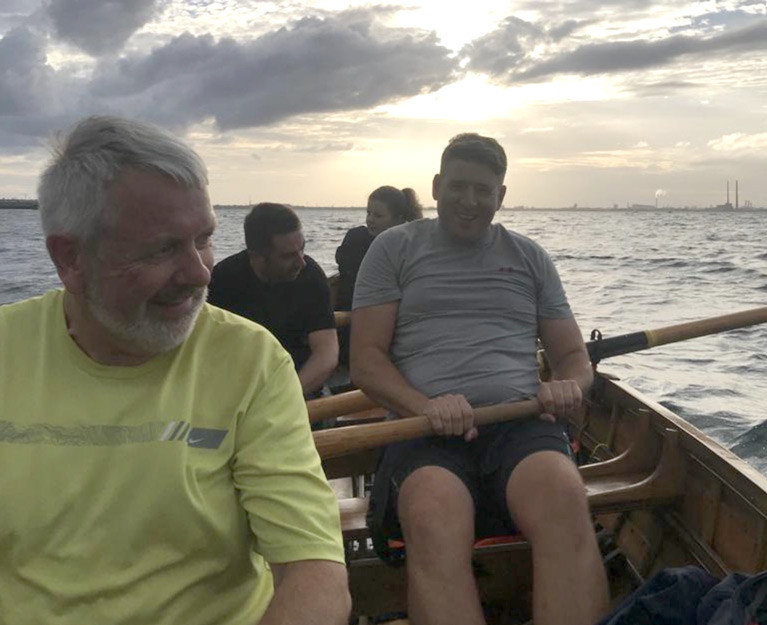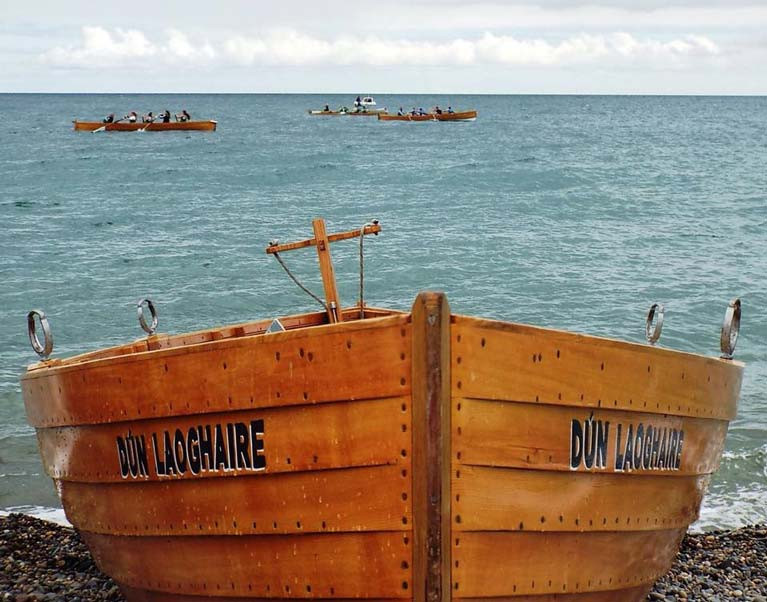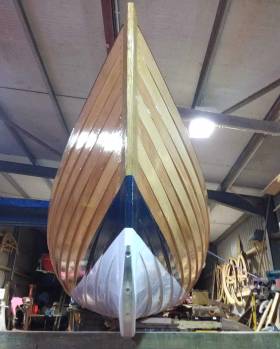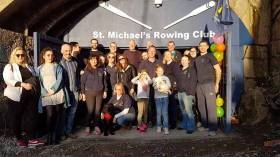Displaying items by tag: St Michael’s Rowing Club
O’Connell Centenary Cup Presented to St. Michael’s Rowing Club by Dún Laoghaire-Rathdown Cathaoirleach
On September 7th, the O’Connell Centenary Cup was presented to the winning crew from St. Michael’s Rowing Club by Denis O’Callaghan, the Cathaoirleach of Dún Laoghaire-Rathdown. The presentation ceremony was held at the County Hall and attended by councillors, members of St. Michael’s Rowing Club, council staff, and representatives of Rowing Ireland. The cup has a rich historical background and was awarded to the winning crew during the Kingstown Regatta in 1875 to commemorate the centenary of Daniel O’Connell’s birth. After more than 70 years, St. Michael’s Rowing Club and Dún Laoghaire-Rathdown County Council revived the event, which will be held annually going forward.
The race was held on July 2023, as part of the Coastival celebrations, and involved traditional east coast fixed seat skiffs with mixed crews of four rowers, two female and two male, plus a coxswain, competing in a sprint across Dún Laoghaire harbour.
The twelve participating coastal rowers, selected from more than thirty people who put themselves forward by means of a chance draw, did not regularly compete or train together.
The winning crew consisted of Sonja Storm, Martin Dowd, Tommy Hammill, Sarah Good Leonard, and coxswain Gary Byrne.
 The O’Connell Centenary Cup was presented by the Cathaoirleach of Dún Laoghaire- Rathdown, Denis O’Callaghan, to the winning crew from St. Michael’s Rowing Club. The cup is on public display in the entrance area of County Hall in Dun Laoghaire
The O’Connell Centenary Cup was presented by the Cathaoirleach of Dún Laoghaire- Rathdown, Denis O’Callaghan, to the winning crew from St. Michael’s Rowing Club. The cup is on public display in the entrance area of County Hall in Dun Laoghaire
Stephen Brady, the Council’s Director of Corporate Affairs, hosted the event and welcomed all the participants.
The Cathaoirleach congratulated the winning crew and spoke about the importance of treasuring tradition. He also highlighted the work of DLR archivist Georgina Sweetnam, whose contribution was crucial for reviving the race and the event itself.
Simone Sav, St. Michael’s Rowing Club Chairperson, expressed gratitude to dlr County Council for their continued support of the club and to Rowing Ireland for their guidance. She also thanked the council’s Harbour Operations Manager, Tim Ryan, and the Harbour Master, Harry Duggan, for their assistance. Marie Kinsella, Chair of the Coastal Division, Shane Russell, Vice-Chair of the Coastal Division, and David Hussey, Rowing Ireland board member, also attended the event.
Gary Byrne, a member of the winning crew, was surprised to see his grandfather’s name, John Byrne, engraved on the O’Connell Centenary Cup dating back to 1944. The cup has been put on display in the entrance area in County Hall, Dún Laoghaire. The race will be held every year, and more crews are expected to join next year.
Two members of St Michael’s Rowing Club in Dun Laoghaire are preparing to row across the Atlantic for a special cause — and faster than anyone has before.
Robert Collins and Kevin O’Farrell are aiming to break the world record for the fastest row from mainland Europe to mainland South America in aid of Muscular Dystrophy Ireland — inspired by the son of a family friend who was diagnosed with Duchenne’s Muscular Dystrophy.
Starting in Portugal this Friday 1 April, they will be rowing as part of a five-person crew, non-stop for at least 48 days across the Atlantic to French Guiana in South America — spending every day together in a small boat, battling the weather and the ocean.
They will be rowing 12 hours each day, two hours on, two hours off. Their crew will be unsupported, carrying all equipment and food necessary to sustain them on their expedition.
The so-called ‘Salty Pair’ has previously trained for the Talisker Whiskey Atlantic Challenge despite no prior experience in rowing, but were forced to withdraw due to the “challenges we faced in preparing for the race during a global pandemic”.
 The five-person crew in training for ‘Kev and Rob’s Atlantic Row’
The five-person crew in training for ‘Kev and Rob’s Atlantic Row’
Robert and Kevin said of their latest attempt: “We’re raising funds for a charity close to our hearts. Fionn, the son of a family friend, was diagnosed with Duchenne’s muscular dystrophy at the age of three. It is a muscle-wasting disease with a poor prognosis.
“Inspired by Fionn’s story, we will be raising funds for Muscular Dystrophy Ireland, who have given Fionn, his family and other afflicted families incredible support through the toughest times a parent can imagine.”
A voluntary organisation, Muscular Dystrophy Ireland supports kids like Fionn and their families by providing a wide range of respite and support services all year round, advocating for their community and educating society about neuromuscular conditions and supporting researchers and clinicians to carry out quality research into neuromuscular conditions.
To support Kev and Rob’s Atlantic Row, donate via the iDonate website HERE. All money raised will go to their chosen charity, with the rowers bearing all costs linked to the row itself.
With the clinking of oars and the rhythmic movement of the traditional skiff gliding through the water – St Michael’s Rowing Club of Dún Laoghaire are now back out on the water enjoying their first row of the season on Monday evening.
Members have been busy during lockdown while waiting for the restrictions to ease to get back out on the water, with participation in the Ocean to City Virtual Challenge 2020 in early June. Massimo De Luca got 1st male and 1st veteran and Gareth Whittington winning 1st male team in a tough race competing against competitors across Europe.
Furthermore, some members competed in the first British Rowing Virtual Championships against 1200 entries from 30 different nations, with brilliant efforts from Dave Cullen who got 7th in the Men’s A final and 10th in the 2000m and Martin Dowd came in 8th in the 500m and Gareth Whittington winning his final.
And while their annual St. Michael’s Regatta was cancelled this year due to COVID, they have their renowned annual Hobblers Challenge rowing race to look forward to on the 12th September 2020 with two courses – the 18km and the 27km distances. Along with traditional skiffs, this year the race will be opened up to Celtic Longboats (Welsh design), and Celtic Yawls (‘All Ireland’ one design).
Skiff rowing in Dún Laoghaire, in common with other East Coast Rowing Clubs, is passed on from the hobblers of old. The hobbler men rowed fishing and pilot boats in Dún Laoghaire Harbour and all around the east coast. They rowed much bigger and heavier boats than the present day skiffs. In the early 1900s, the hobblers of Dún Laoghaire Harbour and elsewhere along the coast were starting to decline as a result of steam and motor engines.
In the early 1920s many of these hobblers and ex-hobblers formed St. Michael’s Rowing Club. Today the vibrant rowing club is made up of all ages and walks of life, from complete beginners to experienced rowers, enjoying coastal rowing in traditional skiffs based in the Coal Harbour in Dún Laoghaire, rowing in the wonderful surroundings of Dún Laoghaire and further beyond to Scotsman’s Bay, the Forty Foot and Dalkey Island.
St. Michael’s Rowing Club, Dún Laoghaire are organising a free live training session for anyone who has access to a rowing machine. The session is provided by Niall O’Toole, rowing Olympian and World Champion. The session will be streamed live on Facebook on Thursday, the 9th of April, at 8.00 pm.
The last few weeks have brought about many cancellations in rowing events, and more are bound to happen. With good reason too, as the safety of rowers and their families is most important, given the current circumstances. Naturally, this has an effect on the rowing community, not only in terms of the sporting calendar but also of the wellbeing of their members.
As many rowers would say, rowing plays an important part in the lives of amateur club members, especially in the spring and summer months. It is an opportunity to work out, stay fit but also to socialise. It is an exercise of being in the present, in tune with crew members, of syncing your movements, your breath and the focus of your attention. Most importantly, it is the practice of generously giving your energy, drive and passion to a crew. That often means getting past the pain barrier and becoming mentally strong to follow your aim. Sometimes the results are there with your crew, sometimes they go to different crews and different clubs, but the benefits are there for all. With this in mind, a group of rowers from the St. Michael’s Rowing Club, Dún Laoghaire, have come up with an initiative of providing a live training session for those who have access to a rowing machine.
The format of the session is: 1 hour long, with 4 areas to cover, relevant for everyone.
- First 15 min: Technique/ Warm Up/ Intro Drills
- Second 15 min: Endurance Rowing Tips and demo
- Third 15 min: 15 Mins Power Pull
- Fourth 15 min: Speed Hit
The session is given by Nial O’Toole of CrewClass. Crew Class was founded by Niall O’Toole, Ireland’s first-ever rowing World Champion, three-time Olympian 1992, 1996 and 2004 Olympics, and former World Record holder.
A multi-medallist, his pioneering international rowing career spanned two decades, including 15 World Championships. Niall will explain all the different aspects of using the erg, and also demonstrate.
The message from the St. Michaels’ rowers is that ‘anyone with an erg can join in - the session is free. We cannot change the present circumstances, but we want to give something back to the rowing community. We hope to be able to provide more free sessions in the upcoming weeks. So wherever you are, whatever level of experience you have, feel free to tune in this Thursday, the 9th of April, starting at 8.00 pm.’
The session will also be uploaded on Youtube within a few days of the live streaming.
St. Michael’s Rowing Club, Dun Laoghaire are hosting the official launching and blessing of their new east coast rowing skiff on Saturday, the 2nd of February 2019. The event will take place at 11 am in Coal Harbour, Dun Laoghaire in the presence of club members, supporters, local community representatives and official stakeholders. Special guest for the event is boat builder Louis Hunkin of W.C Hunkin and Sons, who will be joined by his family.
St. Michael’s Rowing Club has been at the heart of Dun Láoghaire since the 1920s, ensuring the continuity of traditional Irish skiff rowing, which was passed on from the hobblers of old. In the early 1900s, the hobblers of Dún Laoghaire Harbour and elsewhere along the coast were starting to decline as a result of steam and motor engines. However, they would still race each other out to a coming ship to pilot her ashore. They also held races among themselves at the end of the week for sport. The tradition is honoured nowadays through the many skiff regattas along the east coast during the summer months.
"St. Michael’s Rowing Club has been at the heart of Dun Láoghaire since the 1920s"
“Today St. Michael’s is a vibrant and thriving club,” said James Tedd, club Chairperson. “Since 2014 our membership has more than doubled in size. It is heartening to see both youth and adult rowers embrace traditional Irish skiff rowing and carry on this tradition, especially given the fact that we count more than 15 different nationalities among our members. We take great pride in the club’s diversity and inclusive spirit, which is in line with our mission and strategy,” he added.
Gary Byrne, the club Captain, underlined that this dynamic growth in membership has led to a proportional increase in the fleet. “The Gráinne Mhaol, our new skiff, is the seventh boat in our fleet. With more than 65 training sessions per week during peak season, her arrival could not have been more opportune,” he said.
The Captain also spoke about the need for access to proper, adequate facilities for the club members. “We are one of the oldest rowing clubs on the east coast. At the moment, the only premises we have, located in Coal Harbour, are fit for storage and maintenance work,” he added. “We are active, we are determined, and we love to compete and win medals, from the youngest members, barely 10 years of age, to the most experienced vets. Access to facilities would be a huge improvement for our members, and would allow us to continue to grow and promote this sport.”
Amy Smith, club treasurer in 2017-2018, said: “We are grateful for the funding for the Gráinne Mhaol, which was provided under the 2017 Sports Capital Programme by the Department of Transport, Tourism and Sport. Many thanks also to our sponsors for today’s event: Tesco Dun Laoghaire, SuperValu Killiney and SuperValu Dun Laoghaire. And of course, huge thanks to Louis Hunkin, for building the boat and entrusting her to us.”
The ceremony is to be performed by Fr. Martin Daly who blessed not only the Gráinne Mhaol but also the new-to-the-club one design boat, Eibhlín Nua. Chris Greene, club Captain in 2017-2018, is looking forward to ensuring that the boats have a festive champagne baptism before they are launched into the Dun Laoghaire harbour for the first time.
More details about St. Michael’s Rowing Club are available on the website here
St Michael’s Rowing Club, Dun Laoghaire, launched the 2017 coastal rowing season with the official move back into refurbished facilities
Councillor Mary Fayne joined the committee and members of St Michael’s Rowing Club for the official opening of their newly refurbished facilities at the Coal Harbour boatyard in Dun Laoghaire last Saturday.
The coastal rowing club, whose growing membership of men women and children row the heritage class East coast skiffs, is based out of a stone archway. Up until this year, this boatshed had a leaky roof that caused great difficulty for the maintenance and upkeep of these historic boats. Along with providing a watertight home, the boatshed now has hot water, improved lighting and power, storage for oars and equipment, and other minor improvements.
These repairs were made possible thanks to a grant from the Sports Capital Programme and the on-going fundraising efforts of members. This growing club hopes that this is a stepping stone on route to full clubhouse facilities in line with other watersports in the harbour and their sister rowing clubs along the coast.
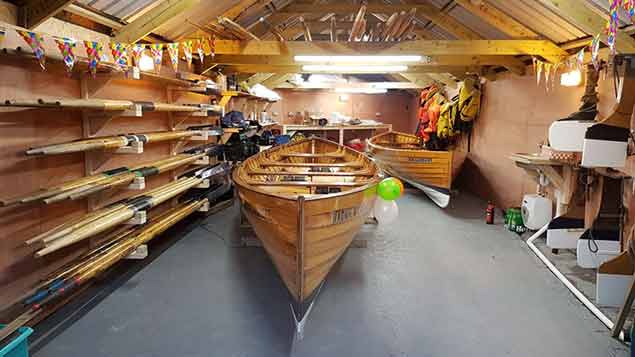 The club's beautiful racing skiffs at home in the refurbished boatshed
The club's beautiful racing skiffs at home in the refurbished boatshed
Last season saw a very successful year for the club, with membership at full capacity, a growing youth section, and the Senior Men’s crew lifting the overall East Coast Rowing Council trophy in their category, and the club placing second overall in the Junior Shield.
The club is holding a further fundraiser race night in Baker’s Corner on Saturday 1st April, and all are welcome – there will be betting, auction and raffles on the night, with a prize pot for the owners of winning horses, with thanks to sponsorship and support of local businesses including Grandstand Sports, K&K Windows, Newtownpark Avenue Service Station, Brady’s Family Ham, Regan Roofing, Frank Keane Volkswagen, Typecraft and Dublin Bay Cruises.
The club will also be doing bag packing at SuperValu supermarket in Blackrock on Saturday 10th June, and all support is greatly appreciated
St Michael’s 'Row' in Behind Environmentally Friendly Scheme
Hundreds of reusable plastic bottles are being distributed to participants in St Michael’s Rowing Club 2015 (SMRC) Urban Run on Sunday October 11th as part a campaign to encourage more people, particularly those engaged in outdoor pursuits and sports activities, to invest in a reusable bottle.
The Environment section of Limerick City and County Council, in conjunction with the Southern Waste Regional Office, is providing 500 participants in the event with the bottles.
Launching the SMRC Urban Run today (Monday, 7 September 2015), Cllr. Liam Galvin, Mayor of the City and County of Limerick, said: "I would like to congratulate St Michael's Rowing Club for opening their doors to celebrate health, community and the spirit of competition with the club’s third SMRC Urban Run. I also welcome the involvement of St Michael's Rowing Club's Urban Run in this project which encourages the use of reusable water bottles."
Antoinette Ahern, St. Michaels Rowing Club Captain stated: "The SMRC Urban Run is now in its 3rd year. We are delighted to assist with this reuse project. Water is hugely important for rowing, from respecting the Shannon and other rivers as the natural resource they are, to ensuring that our athletes are hydrated."
"Our rowers are encouraged to drink water every 15 minutes during training. We have a fresh drinking water tap that we refill bottles from. I would encourage all those involved in sports at a competitive and leisure to invest in a reusable bottle," added Ms. Ahern.
Sinead Mc Donnell, Environment Awareness Officer, Limerick City and County Council commented: "According to a recent article in The Guardian newspaper, globally we now drink as much bottled water as we do milk! Global sales are likely to exceed 233 billion litres in 2015. Over 90% of the cost of a water bottle can be traced back to the bottle, lid and label. You can save a lot of money and help the environment by investing in a multi use reusable water bottle and drinking tap water."
The reusable water bottle project is part of the Local Authority Prevention Network (LAPN), which is funded by the Environment Protection Agency (EPA) under the National Waste Prevention Programme.
"Plastic dominates the bottled water industry," explained Pauline McDonagh Southern Regional Waste Prevention Officer.
She added: "In production, most bottled water is packaged in PET (polyethylene terephthalate) plastic bottles which are derived from crude oil. It can take up to 3L of water to produce 1L of water. Transportation of bottled water around the world requires burning of fossil fuels. Although plastic bottles are recyclable, 20% or 14 million of all the drinks in plastic bottles sold in Ireland last year were not recycled instead they ended up in in landfill and take up to 1000 years to break down. When littered they are a blight on water, land and sea. If that wasn't enough bottled water is expensive.
Helen O Donnell, City Centre Tidy Towns said: "Projects which encourage us to reuse are very important in relation to the National Tidy Towns competition. This ‘Row Run Reuse’ project will definitely be a feature in the City Centre Tidy Towns application for 2016."


























